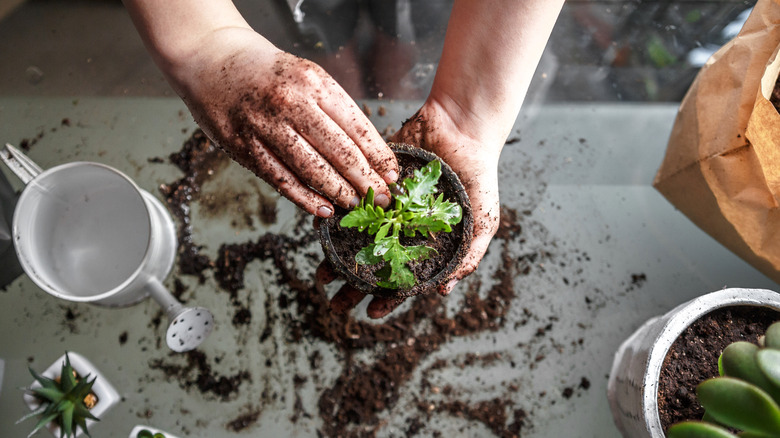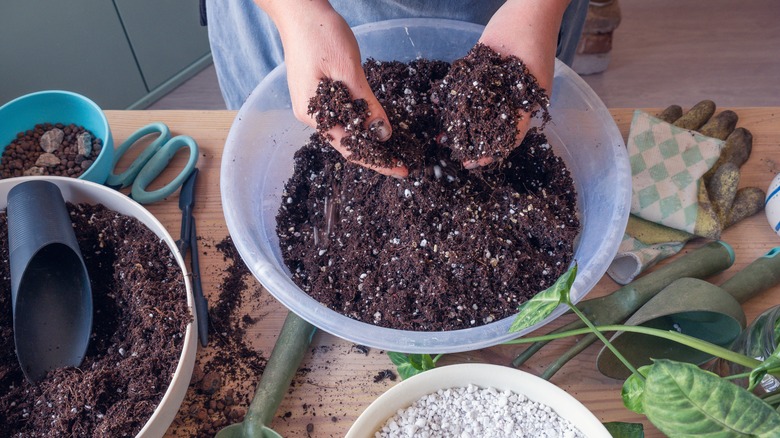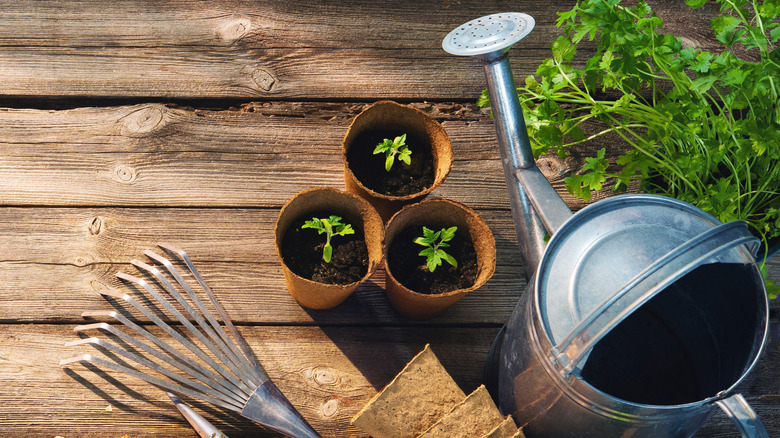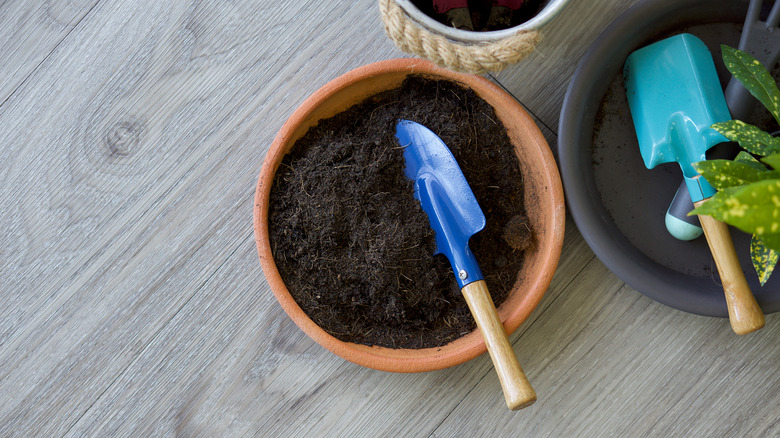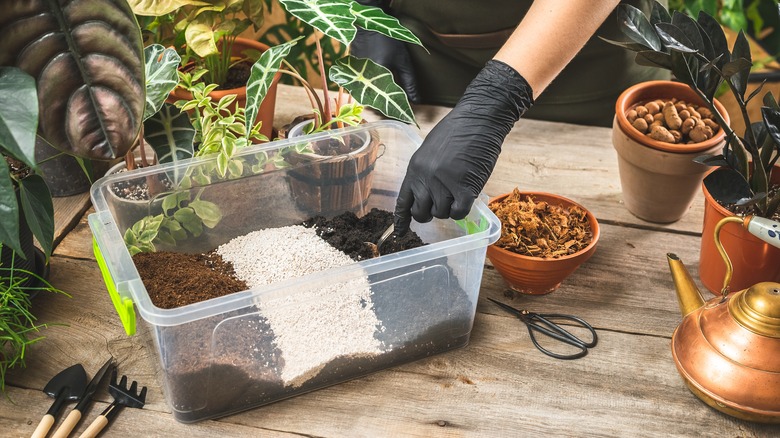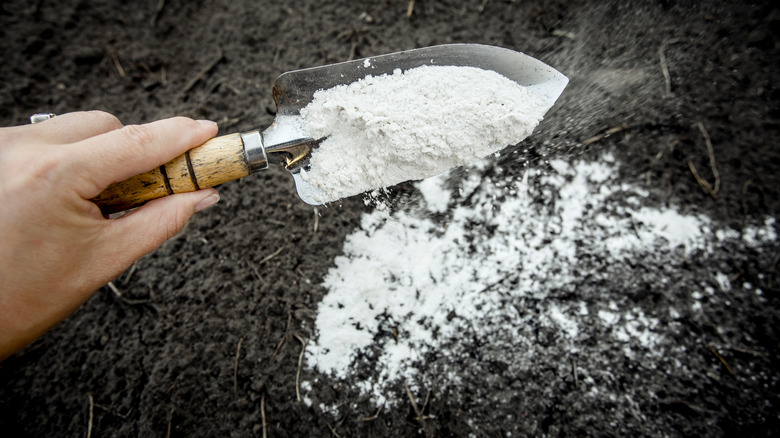5 Pro Tips For Reusing Potting Soil
What do you do with soil after your plant dies? You could throw the whole thing into a compost pile, but you can also reuse the potting soil. Reusing it will allow you to extend its life before eventually tossing it in a compost pile years later. Most commercial potting mixes are formulated to support plants for about a year, so you'll need to put additives in them, according to Plant Addicts.
Before you reuse your dirt, you must ensure it isn't contaminated. It could contain pathogens, viruses, fungi, and pest larvae. If you used this potting mix, your new plants would become infected and die like the original ones you kept in this soil. Instead of reusing or using it for compost, this dirt must get disposed of in a trash can. Using it for any other form of gardening will spread pests and diseases. If your soil is clean, though, you can reuse it for potted plants, flower gardens, and vegetable beds. Of course, you'll need to prepare it to support plant life again.
1. Remove plant matter
Removing the old plant matter is necessary when reusing soil, so the new roots aren't crowded. This step is extra important if you plan on putting your plants in a pot. If the dirt still has old roots, there is limited space for the new plant to grow before it's too large for the container. They'll also cause the potting mix to be compacted, affecting its ability to drain water. It's not such a big deal if you use the soil for an open garden in your yard because there'll be insects and naturally occurring bacteria that are beneficial for breaking up the matter for decomposition, according to Flourishing Plants.
Using a hand trowel or cultivator, sift through your soil. When you see chunks of roots, stems, or leaves, pick them out. They can get tossed in the compost. It can be helpful to pour dirt out onto newspaper, so you have more flat space to look through it. Then lift the side of the paper and pour the soil back into its container.
2. Flush out salt buildup
Salt buildup occurs when there's excess fertilizer in the soil. It can also happen if you're using tap water. To know if you need to switch to rainwater, look at your plant's leaves. You'll see tiny crystal spots or a thin foggy coating on the foliage. It can also occur if you use the same potting mix for years without refreshing it. Either way, you'll need to repot your plant and flush out the soil before making any changes to how you care for them.
Age Old Nutrients explains that flushing or leaching the soil will help because it dissolves all the excess salt. This tactic can also help if you accidentally over-fertilize your plants. What you're going to do is, rinse water through your soil. You should use twice the amount of water for the size of pot you had the dirt in. Then wait for the soil to dry.
3. Sterilize the soil
Sterilizing your potting soil will ensure it's clean and safe to use on healthy plants. Even if you know the original plant didn't die from infected soil, it's better to be safe than sorry. The more you reuse your potting mix, the higher the risk there is for it to have pathogens, fungi, or pest larvae in it. To properly sanitize your soil, you must bring it into the kitchen. Heat kills bacteria or insect eggs, making the soil good as new. The best time to do this is on a nice day because baking soil in your oven will leave a smell. You'll want to open windows and doors for ventilation and choose a baking sheet you don't need for food anymore.
Herbs at Home recommends laying a 3-inch layer of soil on the baking sheet. Preheat your oven to 200 degrees Fahrenheit. Then add water to the dirt. Cover the tray with tin foil and leave it to bake until the soil is at 180 degrees Fahrenheit. You can monitor the internal temperature with a meat thermometer. Once it reaches that temperature, set a timer for 30 minutes, and don't open the oven door. When the timer goes off, switch off the heat and leave the soil to cool down to room temperature.
4. Fluff the soil
After the soil has been used for a potted plant for a while, it'll begin to condense. Since no natural creatures are crawling through the dirt like in the outdoors, the soil will stay compact. If you don't do anything to remedy this problem, it'll be harder for water to flow through it and for air to reach the roots. The first thing you can do is use a hand trowel or cultivator to fluff up the soil. Doing this will break apart any large chunks. Then you can add materials to aerate the potting mix so your future plants won't have any root problems.
Smart Garden Guide recommends following a recipe of 1 part topsoil, 1 part peat moss, and 1 part perlite for an ideal potting mix. Perlite is a crucial ingredient for aeration. It's made of volcanic rock and creates space in the soil so air can reach the roots and water can easily flow. If you can't find perlite, coarse sand will work as well.
5. Add nutrients
Plants need more than just the sun to live. Their roots absorb nutrients from the soil to give them what they need to grow. After fresh potting mix is used for about a year, the plants will have absorbed all of the nutrients. If you want to reuse that soil, you need to use a fertilizer to add those vitamins and minerals back. Monster Gardens recommends using an all-purpose nutrient enrichment. These fertilizers are balanced with nitrogen, phosphorus, potassium, and beneficial microbes.
If you have a compost pile, mixing the finished humus into your soil will add the nutrients it needs to support plant life. You can also use compost tea to do this. When adding these fertilizers to your potting mix, you must be careful how much you add. It's easier to add more later if it looks like your plants need more. However, if you add too much, you can fix it by adding more dirt to the mixture. You don't want a large amount of fertilizer because it can burn your plant's roots, which will already be at risk of transplant shock.
